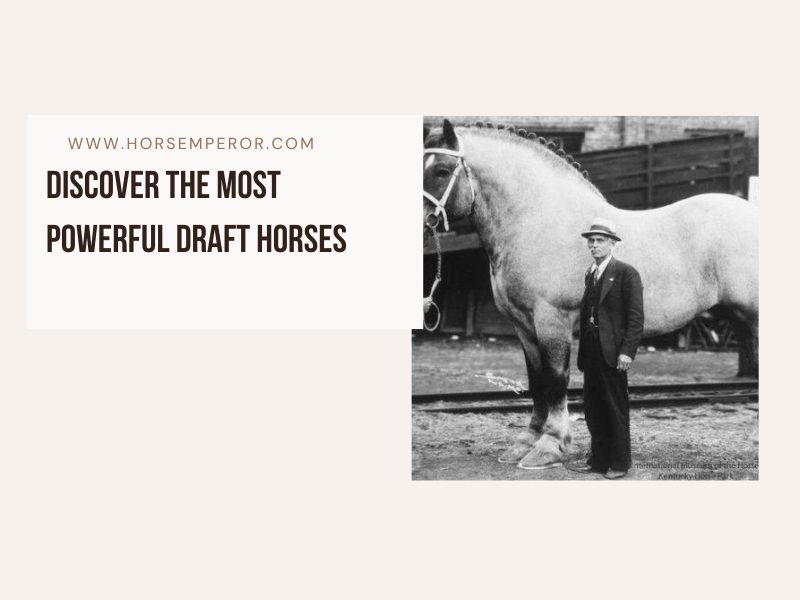Draft horses are large animals known for their towering dray, immense strength, and gentle presence. In the US, they’re known as draft horses, while in the UK, they’re often called draught horses or even carthorses depending on local language. These breeds have been bred over generations to be strong, patient, and willing because they are the perfect partners for hard work.
Back then, they were mostly used in farming, pulling carts, and heavy agriculture. Before the advent of machinery and motorized vehicles, they were indispensable to farmers. These performers were born to pull, haul, and help shape entire civilizations. Generally speaking, they were the ideal solution for heavy manual labor on farms in many countries around the world.
There are a multitude of reasons why these equines are still beloved and appreciated. They are essential in jobs that require stamina, strength, and grace. They are famous worldwide, especially in Europe and the United States, due to their resilience, ethic, and endurance.
They’ve played a significant role in everything from transportation and warfare to shaping civilization. It’s no surprise that some have achieved legendary status, standing as symbols of dedicated service and raw, beautiful power.
What Makes a Horse a “Draft Horse”?
Draft horses are also known as work horses. These heavy horses are known for their massive build, calm nature, and incredible strength.
These amazing breeds have been bred for centuries to do heavy and demanding physical tasks. Their impressive size, strength, and temperament make them unique from other lighter riding breeds.
Physical Traits: Size, Weight & Strength
The impressive size of draft horses makes them easy to identify. Most draft breeds stand between 16 to 19 hands tall. The average weight of these heavy breeds can range from 1,500 to over 2,200 pounds.
Their broad chests, thick necks, strong legs, and heavy bones make them perfect for pulling weight and plowing fields. Powerful breeds like the Shire, Percheron, and Clydesdale are the most popular draft horses.
Temperament & Work Ethic
Despite their bigger size, draft horses are known for being gentle, docile, and willing to work. Even for beginners, their calm nature makes them easy to train and safe to handle.
These intelligent and patient horses are ideal for both manual labor and leisure activities.
Common Uses
In the past, draft horses were mostly used for plowing fields, hauling logs, and pulling carts or wagons. But today, draft horses play an important role in different fields like:
- Farming and forestry work
- Parades and carriage rides
- Draft horse shows and competitions
- Therapeutic riding programs
- Promotional events and film appearances
These horses are perfect for pulling heavy loads and working in rural and urban environments. Their ability to stay focused under pressure makes them a reliable companion.
Draft horses are also crossbred with lighter horses to create sporty yet strong riding horses. These crossbred horses are used in disciplines like dressage, trail riding, and driving.
Top 10 Most Famous Draft Horse Breeds
1. Shire Horse
Life Expectancy:
- 25 to 30 years with proper care.
Height:
- 16.2 to 19 hands high.
- Some exceptional individuals have reached over 21 hands.
Weight:
- Adult Shires usually weigh between 1,800 to 2,400 pounds (800 to 1,100 kg).
- The heaviest recorded Shire (Sampson/Mammoth) weighed 3,359 lb (1,527 kg).
Common Colors:
- Black, bay, and gray are the most common.
- Chestnut is rare and not accepted by some breed registries.
Unique Characteristics:
- Feathered legs (long hair from the knees down).
- Exceptionally calm temperament and gentle nature.
- Known for immense strength and powerful build.
- Historically used for heavy pulling, farm work, and beer cart deliveries.
- Retains a strong cultural presence in English rural traditions.
The Shire is an iconic draft horse from England, known as the tallest, largest, and strongest horse breed in the world. These heavy stallions were mostly used for farm work, road haulage, and towing barges through the canal system.
Shires were once vital to the transport and infrastructure of English rural life. Since the 1970s, mechanized farming and railways have caused its role to decline. However, it is still known as a treasured symbol of agricultural and rural culture
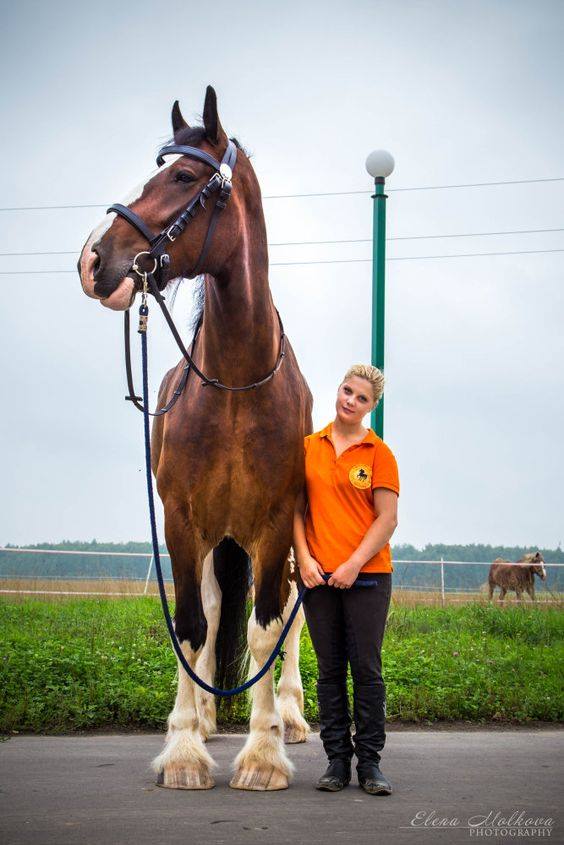
In the UK, Shires were used as horse-drawn carts delivering beer from local breweries. In World War II, due to their sheer stature, they were used as war horses for carrying knights and artillery. But the impact of war and the rise of machinery nearly made them extinct. Through dedicated breeding, some breeders are now trying to preserve their unique markings and place in history.
A Shire named Sampson, later named Mammoth, still holds the world record for the biggest horse. It was born in Bedfordshire in 1850, and stood around 21.25 hands. The weight of this heaviest breed was 3,359 lb (1,527 kg), which is over a ton. In modern day, legends like Wandle Goliath, or Golly, held the Guinness World Record for the tallest Shire horse before passing in July, 2001.
2. Clydesdale
Life Expectancy:
- Typically lives 20 to 25 years.
Height:
- Generally between 16 to 18 hands tall.
- Measured around 162–183 cm or 63.5–72 inches.
Weight:
- Ranges from 1,800 to 2,000 pounds (approx. 800 to 900 kg).
Common Colors:
- Bay (most common), black, grey, and chestnut or sorrel.
- Often with white markings on legs, face, or even under the belly.
Unique Characteristics:
- Feathered hooves and silky lower-leg fringe.
- Broad forehead and long arched neck.
- Known for their trainability, easygoing temperament, and energetic yet gentle nature.
- Frequently used in parades, shows, and commercials due to their flashy appearance and fame in Budweiser and Superbowl advertisements.
The Clydesdale is a heavy breed that originates from Clydesdale, a place in Lanarkshire, Scotland. It is a tall, powerful, and truly beautiful breed, mostly used for publicity and parade purposes.
This breed was formed in the 18th century, when Flemish stallions were crossbred with local mares to improve stature. Later, in the 19th century, Shire blood was also introduced to enhance its power and strength. In height, the Clydesdales are slightly shorter than the Shire, but their feathered hooves, broad foreheads, and neat bodies make them unique and attractive.

In history, these horses played an important role during World War I, towing munitions and supplies across the theatre of war. In 1911, they were among the most exported stallions. But like other draft horses, due to mechanized farming, they were nearly driven to extinction by the 1970s. Their easygoing temperament makes them an ideal companion for training and riding.
The Clydesdales are famous worldwide due to the iconic Superbowl commercials. Every American football fan knows these gentle horses thanks to their appearance in Budweiser ads and Superbowl commercials.
3. Percheron
Life Expectancy:
- Lives 25 to 30 years with proper care.
Height:
- Stands between 15.1 to 19 hands (155–185 cm, 61–73 inches).
- Exceptional individuals like Dr. Le Gear reached 2.13 meters.
Weight:
- Ranges from 1,800 to 2,600 pounds (approx. 820 to 1,180 kg).
Common Colors:
- Usually black or gray, though some variation exists.
Unique Characteristics:
- Muscular build, arched neck, strong legs, wide chest.
- Known for their adaptability, lively temperament, and elegant look.
- Used in mounted police, logging, carriage pulling, and even meat production in France.
- Extremely reliable, making them ideal for both heavy work and public parades.
The Percheron is one of the most famous draft horse breeds, known for its strength, grace, and muscular build. It originates from the Huisne River Valley in France. Its name, Percheron, also comes from its region, once called Perche.
In the 17th century C.E., these horses were used as war horses, to carry knights into battle. In the early 19th century, the blood of Arabians and stallions from other parts was added to their bloodline to increase their size and stamina.
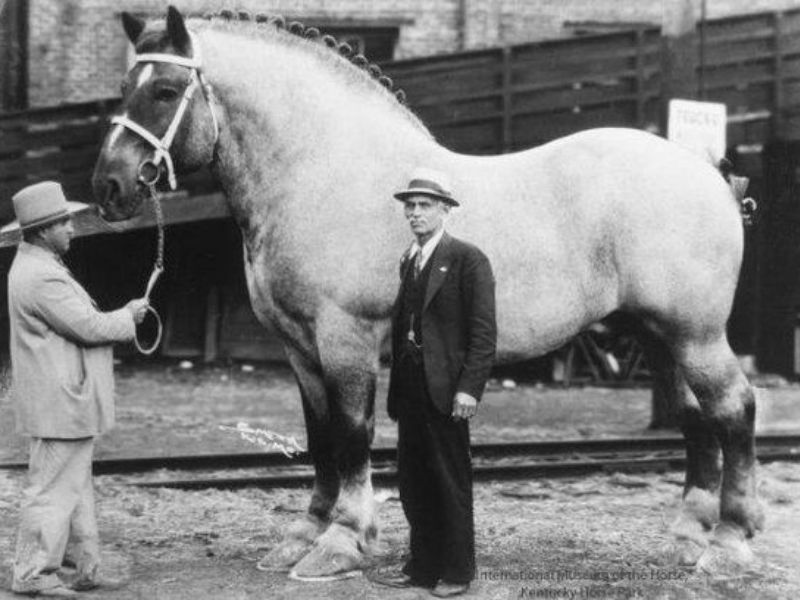
Before the Second World War, they were extremely popular in the US, making up 70% of all draft horses in the country. But like others, their numbers declined due to the mechanization of agriculture. Now, they are extensively used as workhorses and also in competitions and show jumping.
Due to their reduced need, they are now even reared for meat purposes. Their adaptability and lively temperament make them ideal for mounted police horses, carriage pulling, logging, and pleasure riding.
A Percheron mare from Australia once pulled 1500 kg over four meters, showing how strong they are. Dr. Le Gear was the largest horse alive in his time, standing at 2.13 meters. From transporting artillery and soldiers during wars to pulling stagecoaches in peacetime, the Percherons have a long and proud equestrian history.
4. Friesian
Age Expectancy:
- Typically lives 16 to 20 years, with some living up to 25 years with excellent care.
Height:
- Ranges from 14.2 to 17 hands (147–173 cm, 58–68 inches).
- Average height is around 15.3 hands (160 cm, 63 inches).
Weight:
- Typically weighs between 1,200 to 1,400 pounds (544–635 kg).
Common Colors:
- Permanent black.
- Chestnut and bay colors are rare but do exist.
Unique Characteristics:
- Flowing mane and tail with elegant leg feathering.
- Known for their smooth gait, arched neck, and noble head.
- Highly versatile—used in dressage, driving, movies, and even royal ceremonies.
- Gentle, intelligent, and willing temperament.
- Featured in many iconic films for their regal appearance.
The Friesian is a Dutch breed known for its striking looks and smooth movement. It is the most graceful and lighter draft horse that originates from Friesland in the Netherlands.
Due to their strength and agility, they served as prized war horses in the Middle Ages. They have the ability to move swiftly under the burden of carrying riders in heavy armor.
In the 19th century, they were used for pulling the royal carriages of England. In dressage, they are used in harness and under saddle. Friesians are admired for their versatility, elegance, and smooth gait. But due to their slight frame, they are less suited for arduous work like farming.
In the modern era, Friesians have showcased their regal appearance in numerous films and movies. Some popular titles include The Chronicles of Narnia, The Legend of Zorro, Clash of the Titans, Conan the Barbarian, Ladyhawke, and The Hunger Games.
5. American Cream Draft Horse
Age Expectancy:
- Typically lives between 25 to 30 years.
Height:
- Stands at 15 to 16 hands high.
Weight:
- Weighs approximately 1,600 to 1,800 pounds.
Common Colors:
- Known for its cream-colored coat,
- Pink skin,
- Amber eyes,
- White mane and tail,
- May have white markings on the body.
Unique Characteristics:
- Only draft breed developed in the United States that is still in existence.
- Descended from a mare named Old Granny, known for her champagne-colored coat.
- Famous for its gentle, calm, and trainable nature.
- Suited for farming, driving, shows, and riding.
- Structurally built with a wide chest, short strong back, and muscled hindquarters.
- Considered increasingly rare today, with fewer than 2000 horses worldwide.
The American Cream Draft is a historic breed that originated in Iowa in the early 20th century. It is the only rare draft breed that is still in existence in the United States. It is known for its cream-colored coat, amber eyes, and white mane and tail, which give it an elegant look. Its roots trace back to a foundation mare that was famous for her champagne-colored coat.
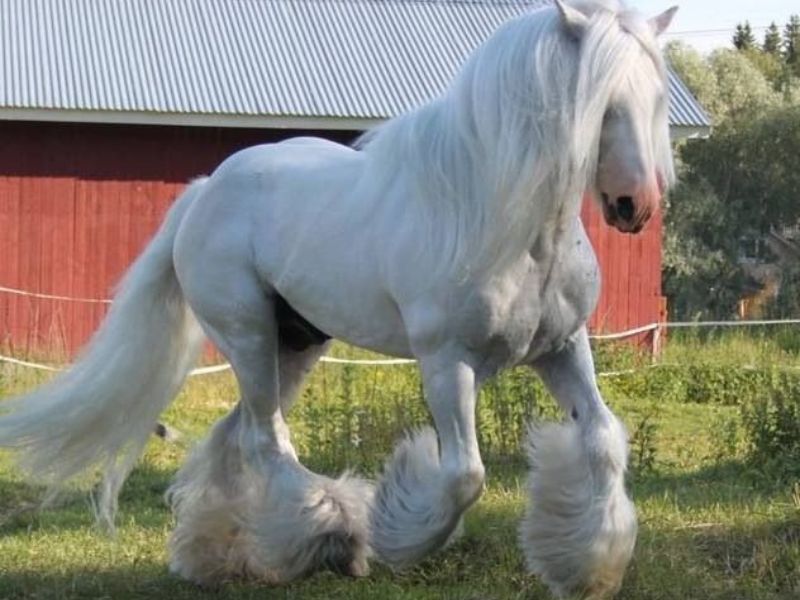
Due to its calm, friendly, and gentle nature, it is easy to train and manage. Its calm temperament makes it ideal for farming, driving, shows, and even riding. It has a wide chest, short, strong back, and muscled hindquarters, making it perfect for heavy farm work.
But due to technological advancements and the mechanization of agriculture, it has also seen a sharp decline in numbers. Worldwide, their population is now fewer than 2,000, which makes them increasingly rare.
6. Jutland Horse
Age Expectancy: Live 20–25 years.
Height:
- 15 to 16.1 hands (152–165 cm, 60–65 inches)
Weight:
- 1,430 to 1,760 pounds (650–800 kg)
Common Colors:
- Primarily chestnut, also found in bay, gray, black, and roan with white markings
Unique Characteristics:
- Compact and muscular build
- Calm and willing temperament
- Known for pulling beer wagons at Carlsberg Brewery
- Features a convex profile, short arched neck, and wide chest
- Historically used by Vikings, in war, and for heavy draft work
The Jutland horse is a draft breed that originates from the Jutland Peninsula of Denmark. It is the descendant of the horses used by the Viking raiders in the 9th century. The modern Jutland is a result of crossbreeding that began in the late 19th century.
This compact, muscular breed is used for farm work and is mostly seen at horse shows and demonstrations. The Carlsberg Brewery in Copenhagen still uses Jutlands to transport beer.
This amazing horse features a convex facial profile, short arched neck, low withers, wide chest, straight shoulder, and a slightly sloped croup. It has strong draft ability, a willing temperament, and a calm demeanor.
In 1897, the Jutland was praised as one of the best heavy draft breeds by the United States Bureau of Foreign Commerce. The Jutland horse was mostly used for pulling carriages and heavy goods. But sadly, their numbers declined rapidly, and according to reports, only 1,000 purebred horses remained by 2011.
7. Dutch Draft Horse
- Lifespan: 20–25 years
- Height: 15.2 to 16.2 hands
- Weight: 1,500–1,800 pounds
- Colors: Commonly chestnut, gray, and bay
The Dutch Draft Horse is a powerful draft breed that originates from the Netherlands. It’s known for its wide neck, chunky body, and short legs. This heavy breed features small ears, compact eyes, and a somewhat unusual appearance.
This majestic breed was developed in Belgium after World War I by crossbreeding Zeeland horses with top-tier draft breeds. Often referred to as a powerhouse, it was built for heavy labor. However, with only around 1,000 individuals remaining by 2009, its population has declined due to mechanization.
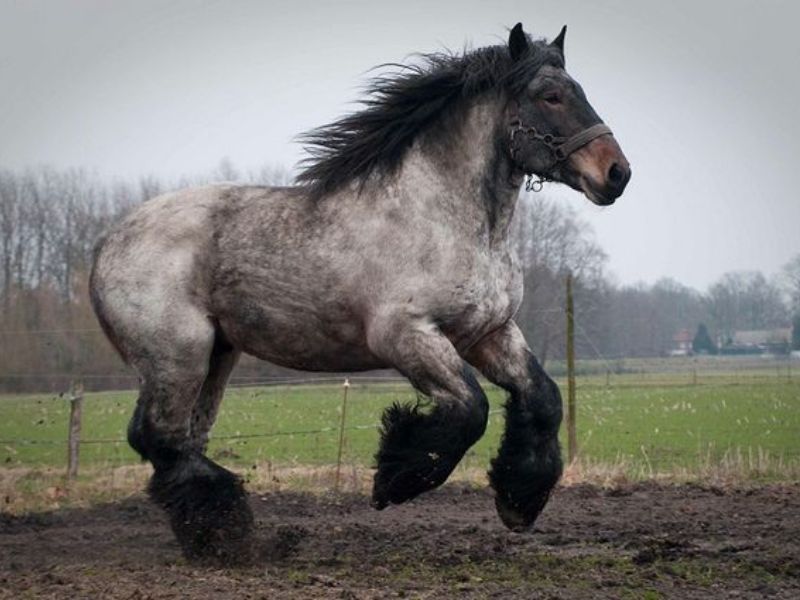
Traditionally used for hard tasks like pulling plows, carts, and handling demanding farm work, today you’ll find this breed active in farming, forestry, and carriage driving during parades and events. Its calm and gentle temperament makes it a reliable and steady companion.
8. Suffolk Punch
- Lifespan: 25–30 years
- Height: 16.1 to 17.2 hands
- Weight: 1,900–2,200 pounds
- Color: Always chestnut (various shades)
The Suffolk Punch is one of the oldest native breeds from Suffolk, England. This rare draft horse is recognized for its rounded build, short muscular legs, and dense bone structure. Its rich chestnut color, sometimes accented with white markings on the face or legs, gives it a distinctive look.
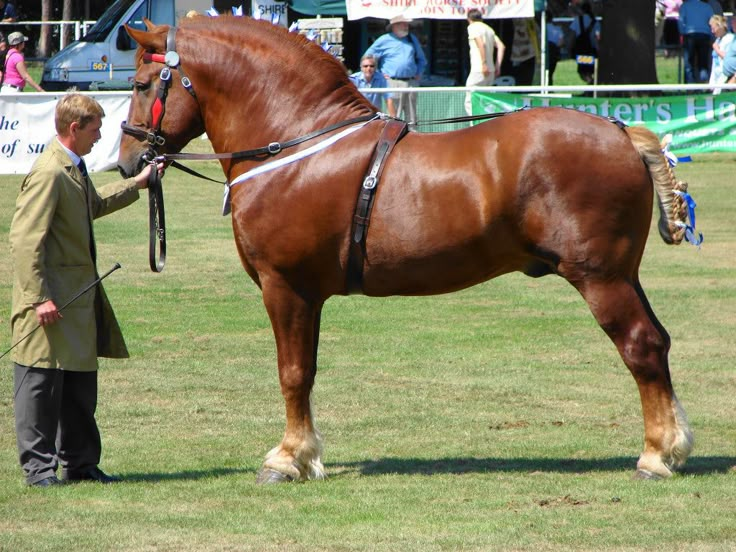
The breed originated in Great Britain during the 1500s and was valued for its ability to pull through the swampy terrain of the British Isles. Unfortunately, with the rise of machinery in the late 1940s, their numbers sharply declined.
By the 1950s, they were nearly extinct. Today, the American Livestock Breeds Conservancy has listed the Suffolk Punch as critically endangered.
9. Ardennes Horse
- Lifespan: 20–25 years
- Height: 15 to 16.2 hands
- Weight: Up to 2,200 pounds
- Colors: Bay, roan, chestnut, and gray
The Ardennes horse is one of the oldest draft breeds in the world. This heavy breed originates from the Ardennes region of Belgium, Luxembourg, and France. It’s known for its unique appearance, stocky build, and thick feathering on the legs.
Thanks to its calm temperament and strong stamina, it’s especially suited for mountainous or rough terrain. In the past, this breed played a vital role in both warfare and agriculture. Even today, this amazing horse is used for logging, pulling, and even meat production in some parts of Europe.
10. Belgian Draft
- Lifespan: 17–24 years
- Height: 16 to 18 hands
- Weight: 1800-2,400 pounds
- Colors: Bay, roan, chestnut, and gray
The Belgian Draft is one of the most popular draft breeds, originating from Belgium. This large horse is recognized for its calm nature and intelligence. Its wide back, muscular body, and feathered legs give it a look similar to the Clydesdale.
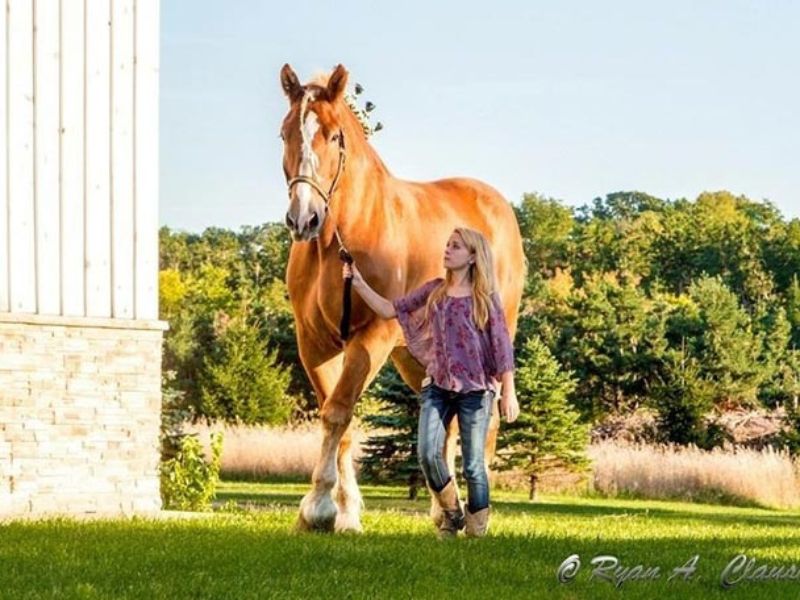
It’s mostly used as a carriage horse, but thanks to its incredible strength and ability to pull great weights, it has also earned victories in many strength competitions. Beyond that, it’s still a reliable worker in forestry, farm labor, and even sledge pulling.
Famous Draft Horses In History
The tall and large draft horses are known for their amazing records and rich history. The gentle giant Big Jake stood at 20 hands, shoes off, and weighed around 2,600 lb (1,182 kg)—a world-wide sensation.
He was honored as the tallest living horse by the Guinness World Records in January 2010 and held that title until June 2021. Big Jake was raised at Smokey Hollow Farm in Poynette, Wisconsin, where his calm temperament, friendliness, and presence drew global admiration.
Another legendary name is Farceur, a foundational stallion who was imported from Belgium to the United States. Born in 1910, this incredible Belgian draft horse won multiple grand championships at the National Belgian Show. Known for his undefeated show record in Iowa, Farceur retired in 1916 and went on to stood at stud, shaping one of the most influential draft breeds in existence today.
Then there’s Old Granny, a lesser-known mare who changed the course of American horse history after appearing at a farm sale in Story County. With mixed draft bloodlines—Belgian, Percheron, Grey, Dunn, and Sorrel—she had unique cream coloring and a sturdy draft build. A local veterinarian, Eric Christian, saw her potential, especially in her foal, a colt named Nelson’s Buck, foaled in 1920.
He had the same coloring and was later used for studding to expand the gene pool. After forty years of dedication, the American Cream Horse Association of America was officially chartered in July 1944—making it the only breed of draft horse developed in the United States.
When it comes to value, few can forget the record-breaking sale of Pleasant County Supersonic—a 3-year-old Belgian sold at the 2022 Mid-America Draft Horse Sale for a stunning $137,500 USD. This marked the third time in twenty years that the event set a world record.
Previously, in 2003, Mcllrath’s Captain Jim, a 2-year-old Belgian stallion, sold for $112,500 USD in Gifford, Illinois. These horses were passed between notable owners like William Helmuth, Allen Detweiler, James Raber, and Orla Yoder, proving that prestige and demand still exist for these majestic animals.
Some horses have etched their names permanently in history books:
- Sampson: The biggest horse ever recorded, weighing 3,359 lb (1,527 kg) and standing at 21.25 hands, born in Bedfordshire in 1850.
- Wandle Goliath (“Golly”): The tallest Shire horse in modern day history, holding a Guinness World Record until his passing in July 2001.
- Brooklyn Supreme: The tallest recorded Belgian, standing at 20.2¾hh, surpassing the maximum height of most Belgians (17hh).
- Dr. Le Gear: A Percheron known for reaching an astonishing 2.13m in height.
- An unnamed mare in Australia: Set a record by pulling 1500kg over 4 meters.
- And in February 2015, during the 100th anniversary of the Mullahead & District Ploughing Society Ltd in Portadown, Co. Armagh, UK, 84 horse teams—more than ever seen before—participated in ploughing the same field.
Why Draft Horses Still Matter Today
Modern mechanization and industrialization have impacted the population of draft horses. But due to their strength, stamina, and calm temperament, they still remain relevant in many fields of the modern world. They are used for heritage farming and sustainable forestry.
These horses are perfect for parades, public demonstrations, and educational purposes. They’re also involved in therapeutic riding, special needs programs, and cultural preservation, especially in rural communities. Draft horses reflect our history and provide a living link to our agricultural and military past.
Draft Horse Care and Management
Caring is very critical for draft horses to keep them calm and healthy. They are bred for strength, so they need a different diet and nutrition than lighter horse breeds. They require more spacious housing and specialized hoof care. Unlike average-sized horses, the horseshoes for draft horses should be custom-made, wider, and significantly heavier. It is a costly procedure, but it supports their joints and overall health.
Exercise is also very important to keep your horse fit. Moderate activities like pulling or light riding improve circulation and prevent stocking up in the legs. You should avoid prolonged stall time for breeds prone to progressive lymphedema or shivers, because it can cause swelling and stiffness. You should provide them a turnout space with secure fencing, designed to accommodate their larger size, because your horse can get stuck or cast in a restrictive, standard-size stall.
Draft horses often have feathering around the pastern that can trap moisture and debris. So, grooming is critical to avoid diseases like dermatitis or skin infection. Cleaning and drying their legs regularly should be part of your routine. Proper hoof trimming and veterinary check-ups — like dental, deworming, and vaccinations — are necessary parts of good management.
References:
- Clydesdale Breed History
- Guinness World Record of Tallest Horse Ever in 2010
- BBC News Record Draft Horses 100th anniversary of the Mullahead & District Ploughing Society Ltd
- American Cream Draft Horse History
- Most Expensive Horse Sold Guinness World Record
- US Davis Center for Equine Health About PSSM
